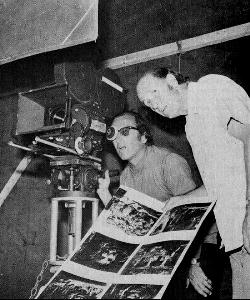
THE GOLDEN VOYAGE OF SINBAD
Columbia Pictures Corporation
US (1974): Adventure
105 min., G, Color
Sinbad battles the creatures of legend in the miracle of Dynarama!
 |
THE GOLDEN VOYAGE OF SINBAD
Columbia Pictures Corporation |
John Phillip Law .... Sinbad
Caroline Munro .... Margiana
Tom Baker .... Koura
Douglas Wilmer .... Vizier
Martin Shaw .... Rachid
Grégoire Aslan .... Hakim
Kurt Christian .... Haroun
Takis Emmanuel .... Achmed
David Garfield .... Abdul (as John D. Garfield)
Aldo Sambrell .... Omar
Fernando Poggi
Directed by Gordon Hessler; Written by Brian Clemens (also story), Ray Harryhausen (story); Cinematography by Ted Moore; Original music by Miklós Rózsa; Production Design by John Stoll; Costume Design by Verena Coleman, Gabriella Falk; Film Editing by Roy Watts; Produced by Charles H. Schneer, Ray Harryhausen; Special Masks: Colin Arthur; Continuity: Eva Del Castillo; Dubbing Editor: Peter Elliott; Assistant Director: Miguel A. Gil hijo; Camera Operator: Salvador Gil; Art Director: Fernando González; Special Visual Effects: Ray Harryhausen; Set Dresser: Julián Mateos; Production Supervisor: Roberto Roberts; Sound Recordist: George Stephenson; Make-up Artist: José Antonio Sánchez; Assistant Editor: Jeremy Thomas; Sound Recordist: Doug Turner;
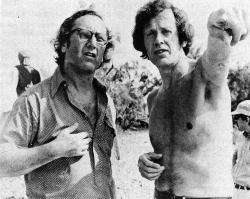 |
Charles Schneer with director Gordon Hessler |
Ray returned to the Arabian mythological world with THE GOLDEN VOYAGE OF SINBAD. Ray had made a few improvements on his animation technique which showed much less contrast between the rear-projected live action footage when combined with the stop-motion footage. Many of the sequences are virtually seamless making it nearly impossible to see where the two images are joined. To draw attention to the improved process, the DYNAMATION credit was changed to DYNARAMA for the release of the movie.
John Phillip Law makes a striking Sinbad in the film. His interpretation of Sinbad is markedly different than Kerwin Matthews. Law's Sinbad as almost overly confident and cocky, which is more in tune with the nature of this film. Caroline Munro adds a beautiful love interest for Sinbad. Her disarming smile and stunning good looks in her costume may be distracting, but what a wonderful distraction. Douglas Wilmer, who played Pelias in JASON AND THE ARGONAUTS, plays the Grand Vizier. While his head is covered with a golden mask to cover his hideously marred face through most of the picture, his marvelous voice is filled with tonal inflection that doesn't need facial expressions to make it's point. Rounding out this excellent cast is Tom Baker as the wicked magician, Koura. Best known for his role as the fourth Doctor in the BBC series DOCTOR WHO, Baker fills this role with a cold, yet impassioned evil. He is certainly the best villain in a Harryhausen picture since Torin Thatcher's Sokurah in THE SEVENTH VOYAGE OF SINBAD.
Gordon Hessler's direction of the film is on target. His use of closeups enlivens the Brian Clemens script making full use of the actors in the film. Hessler manages to keep the sequences not involving Ray's stop-motion work moving at a brisk pace making the film appear to be much shorter than it's 105 minutes running time. This is, at times, a much darker film than the usual Harryhausen film, perhaps due to Hessler's direction and the Brian Clemens script. Miklos Rosza's score adds another excellent dimension to the film. The score is rich in Arabic themes and from the opening credits sequence on, Rozsa translates the action and drama of the story brilliantly.
Ray's animation is again, excellent, as though you'd expect anything less. The first creature he brings to life on the screen is the tiny Homunculus. Though tiny, this winged creature is brilliantly detailed and animated conveying the true evil nature of the creature. When the creature takes flight, Ray's animation is remarkably smooth and the wires from the supporting aerial brace are virtually impossible to detect. The creature is first seen right after the opening credits flying above Sinbad's ship, carrying a metallic object that will be crucial to the film's storyline, but it isn't until later, when the creature is with Koura and then again when he is spying on Sinbad and the Grand Vizier that we really get to see the creature. He is most certainly demonic looking with it's pointed ears, serpent-like tale and bat's wings.
As Sinbad and crew return to sea on their grand mission of restoring the Vizier to his rightful station that we meet the second creature from the film. Like the Homunculus, she makes her first appearance right after the opening credits as the camera captures the front of the ship at sea. Referred to as the Siren, she's the wooden headmast of Sinbad's ship, brought to life by Koura's evil magic. The animation here is deliberately jerky, like Talos in JASON AND THE ARGONAUTS. Breaking free, she moves as you would imagine a creature made out of wood moves. Her face is pale and lacking emotion, making her appear cold and heartless. It also helps that this sequence takes place in the dark, adding to the nightmarish quality of the sequence. The entire sequence takes up only a small part of the screen action, but Ray fills every frame with brilliant motion.
Perhaps the best creature-animated segment in THE GOLDEN VOYAGE OF SINBAD is the six-armed Kali. Like the Siren, she is brought to life by the magic of Koura but it is really Ray's magical animation that truly suspends the disbelief that this could not happen. Koura is captured by natives during his quest for the third and final part of the metallic map. Using his powerful evil magic, he brings the statue to life as she begins a dance. This is Ray at his best. Each movement and gyration is smoothly executed and it's hard to accept that it's all animation. The sequence is also helped by the stylized and fitting use of the sitar in the Rosza score. As Sinbad and his crew arrive, Koura turns the statue on them as Ray beautifully animates six sword-wielding arms in a battle against Sinbad and his men. The match between live-action and stop-motion is excellent making this sequence one of Ray's finest moments to date. One particularly stunning moment has Kali following Sinbad up a small set of stairs that will leave many animation buffs wondering how Ray accomplished it.
Sinbad finds the third part of the map but all seems lost when Koura tells the natives that Sinbad has killed their god Kali. The natives are preparing to kill Sinbad when Margiana raises her hands and yells stop. Seeing the single eye on her right hand, the native believe that see is a gift to be sacrificed to their one-eyed god. They lower her into a pit as Sinbad and crew watch helplessly as the half-man/half-horse Centaur arrives to take her into his cave. Margiana faints at the sight of the creature who then picks her up. While the Margiana in the Centaur's arms is a Harryhausen animation, he does a much better job of making her looked limp and unconscious than many actresses who have been picked up and swept away after passing out. The Centaur is superbly designed and animated. Ray gives the Centaur complex motion that depicts the uncertain movement of a man struggling with a horses body. There are brilliant hesitations in the steps of the creature it appear far more unearthly than if Ray had animated it like a real horse.
With the natives briefly distracted as The Grand Vizier opens his golden mask to reveal his hideously deformed face, Sinbad and his men make their escape to pursue and rescue Margiana. This sequence, and most of the remainder of the film takes place in a cave. The cave is brilliantly light with rich and vibrant colors adding to the fantasy element of the film. Koura, who now has possession of all three metallic pieces has made his way to the the Fountain Of Destiny where each piece will grant him a gift, one of youth, another with a shield of darkness, and the final, a crown of riches untold. Throughout the film, Koura has been sacrificing his own youth with every magical spell he has cast. At the point where he reaches the Fountain of Destiny he has become an old man through the striking and effective use of makeup, making him appear withered along with Baker's acting skills which give him a feeble near death appearance. Sinbad arrives in time to steal two pieces of the metallic map but Koura has already used the first, restoring him to his youth. Calling upon evil forces to help him, Koura has summoned the Centaur who begins another skillfully edited and animated sequence in a battle with Sinbad. The fight doesn't last long since, along with the power of evil Koura has also summoned the power of good in the form of a Gryphon. Like the Centaur, the Gryphon is also a creature of conflict. With the wings and head of an eagle and the body of a lion, the gryphon makes a formidable foe for the Centaur. The fight between the two creatures is another high-water mark in Ray's animating career. The two creatures are equally matched in strength and it is only the intervention of Koura, who slices the rear leg of the Gryphon that the sequence comes to an all to abrupt conclusion. The slicing shot is brilliantly matched to the stop-motion animation leaving it, again, difficult to see the matte lines. After defeating the Gryphon, the Centaur turns his attention on his human enemies once again allowing Ray to show his remarkable ability to combine live-action with stop-motion is seamless style.
The special effects for the climactic fountain sequence are also brilliantly executed. In this sequence, Sinbad must battle the now invisible Koura, who has used the second piece of the metallic object to obtain the shield of darkness. Set against the backdrop of a gigantic flowing fountain, Koura slowly becomes invisible until Sinbad is fighting a floating sword. In spite of a few problems with transparency, this sequence is genuinely exciting and suspenseful. The floating sword makes powerful swipes and is matched perfectly to Sinbad's actions and reactions. Koura, dispensing of the sword is now totally invisible but makes the mistake of leaping into the Fountain of Destiny where he plans to throw a knife into Sinbad's back. Margiana screams a warning to Sinbad who turns in time to lunge a fatal blow with his sword into Koura's abdomen. The Fountain turns to the color blood and Sinbad steps away, finally rid of the evil magician. With the final piece of the map, Sinbad tosses it into the fountain where his reflection reveals him as King encrusted with jewels. This is another excellent special effect, with the reflection perfectly matching the movements of the real Sinbad.
Pausing, the crown appears in the water and Sinbad removes it to place it on the head of the Grand Vizier. Using dissolves, the mask turns to crystal and then final disappears completely revealing a totally renewed and unscarred Grand Vizier. The movie ends with everyone at sea, returning home as Margiana asks Sinbad why he gave up the kingdom and it's wealth. Sinbad replies that a king is never free and that he values his freedom more than anything, including his right to choose his own wife.
THE GOLDEN VOYAGE OF SINBAD was a worthy successor to Ray's 7TH VOYAGE OF SINBAD. There are comic elements in the film that are never distracting to the greater adventure of the film. The combination of effects, script, direction, cast and scoring makes this a rousing fantasy adventure that is sure to please it's audience. It proved to be successful enough to generate interest in a third Sinbad film, SINBAD AND THE EYE OF THE TIGER.
All three of the Harryhausen Sinbad films are inspired by THE SEVEN VOYAGES OF SINBAD from the ARABIAN NIGHTS stories. Clicking on the above links will send you to etext versions of the original stories.
Merchandising
Japanese Poster |

Pressbook |
STILL GALLERY
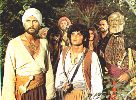 |
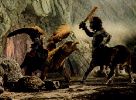 |
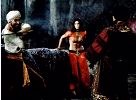 |
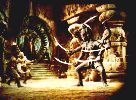 |
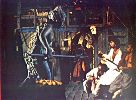 |
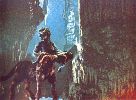 |
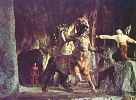 |
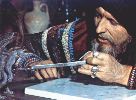 |
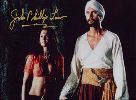 |
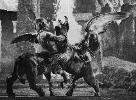 |
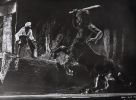 |
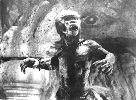 |
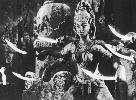 |
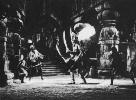 |
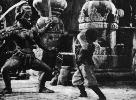 |
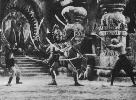 |
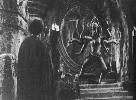 |
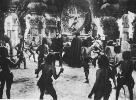 |
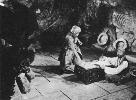 |
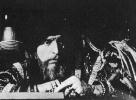 |
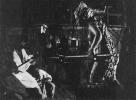 |
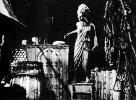 |
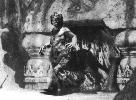 |
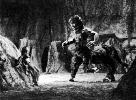 |
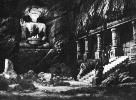 |
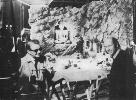 |
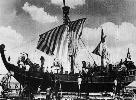 |
SKETCHES
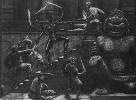 |
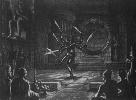 |
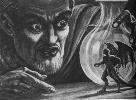 |
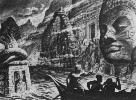 |
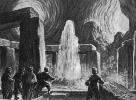 |
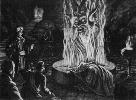 |
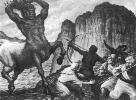 |
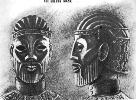 |

| Home | Features | Short Subjects | Autographs | Equipment |